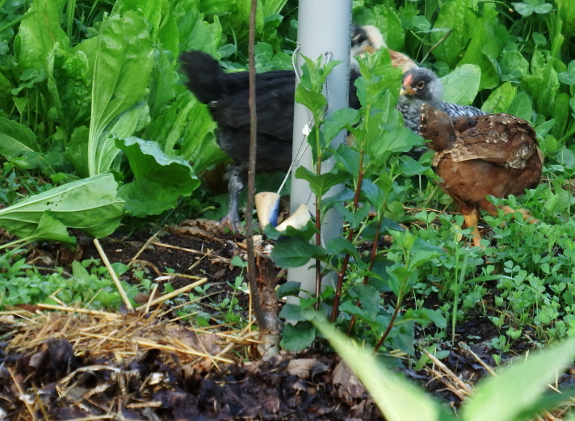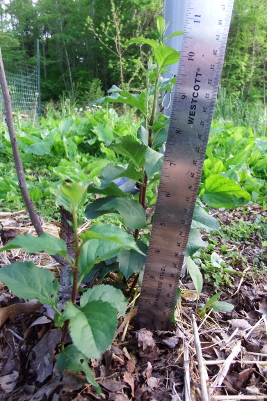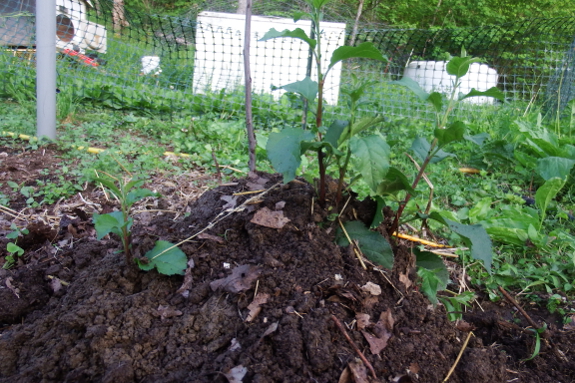
Mounding up soil around a rootstock stool

 If
one of your fruit trees dies a wintry death, but the yank test says
there's still life left in the roots, you can choose to either wait a
year and then graft onto that rootstock, or to turn the area into a
rootstock-propagation zone. I opted for the latter with the
winter-killed apple tree shown above.
If
one of your fruit trees dies a wintry death, but the yank test says
there's still life left in the roots, you can choose to either wait a
year and then graft onto that rootstock, or to turn the area into a
rootstock-propagation zone. I opted for the latter with the
winter-killed apple tree shown above.
If you're interested in propagating apple rootstocks, you should read this post first since it explains the whys and hows of stooling. Do it now. I'll wait.
Are you back? Okay, so
you'll notice that my winterkilled apple sent up five sprouts of various
sizes from the rootstock (the largest four of which you can see in the
photo above). The Grafter's Handbook
recommends waiting until those sprouts are five to six inches tall (I
waited a bit too long), then hilling them up just like you would a bed
of 'taters.

The idea is to cover
about half of each sprout's length with earth, and it's worth taking
some time to work the soil in with your fingers to thoroughly fill all
the air gaps between sprouts. Once the sprouts grow a little higher,
I'll hill a little more so I continue to have half of each stem's length
(hopefully six to eight inches by the end of the season) buried in the
soil.
(You'll notice we also
fenced the little scratchers out. Always a good idea to make sure your
chickens don't knock down the mounds of soil you build up....)

Varieties are chosen to
be rootstocks in part because they're keen rooters, so in my official
stooling areas, I chopped the tops off the one-year-old trees in early
spring and stuck those tops halfway into the ground several inches away
from the original stool. In the photo above, the stem is on the left and
the rootstock is on the right (by the rebar). As you can see, both
parts of the tree are currently leafed out and growing. Since this stool
is younger than the one shown in the previous photos (one year old
versus 2.5 years old), it's not as advanced and won't be hilled for a
few more weeks.
The good news is that it
looks like, if everything goes smoothly, I won't have to buy apple
rootstocks this year. Now, the question is, where will I put another
half dozen home-grafted apple trees?
Want more in-depth information? Browse through our books.
Or explore more posts by date or by subject.
About us: Anna Hess and Mark Hamilton spent over a decade living self-sufficiently in the mountains of Virginia before moving north to start over from scratch in the foothills of Ohio. They've experimented with permaculture, no-till gardening, trailersteading, home-based microbusinesses and much more, writing about their adventures in both blogs and books.
Want to be notified when new comments are posted on this page? Click on the RSS button after you add a comment to subscribe to the comment feed, or simply check the box beside "email replies to me" while writing your comment.
